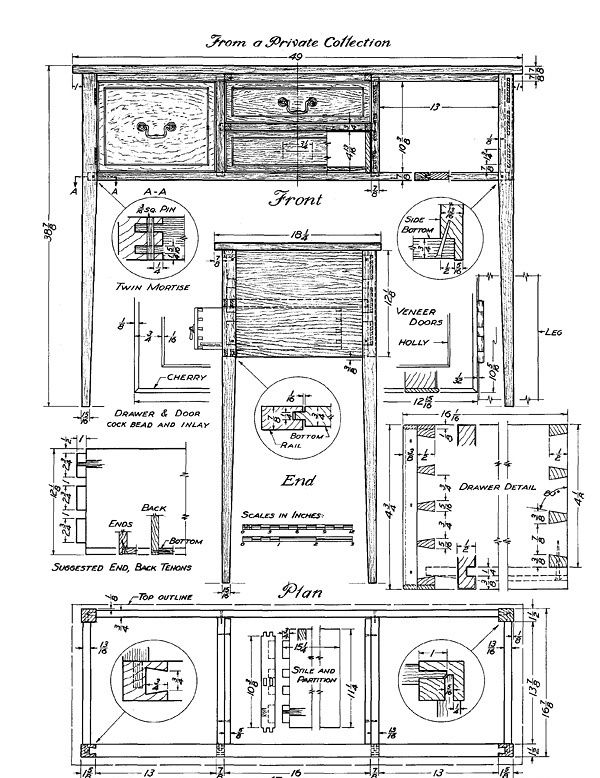A Southern Huntboard
Cock bead is an elegant touch for doors and drawers
Synopsis: Carlyle Lynch adapted this huntboard, or sideboard, from one that spent time at the Museum of Arts in Richmond. It has four legs instead of the six usually found on sideboards, and it’s of a convenient size, he says. It can be made longer, deeper, or taller without destroying its appearance. He recommends keeping the cock bead on the edges of the doors and drawer fronts, and he says building the piece is straightforward – the carcase consists of two solid wood sides and a back mortised into the four tapered legs. Rails attached to the front legs provide openings for the doors and drawers. He gives step-by-step instructions, and the article includes a detailed project plan and dimensions of the piece.
“With the Southern forests rich with game and the housewife eager for the results of the day’s hunt,” wrote Paul Burroughs in Southern Antiques, “the sport was engaged in by all classes. The hunting boards around which the owners of Southern plantations gathered before and after the hunt resemble the sideboard. They were often simple in design. . . As a general rule, they were taller than sideboards . . . and were used chiefly in halls, where members of the hunt could stand and partake of wine and food in the fashion of a buffet lunch.” Besides serving as informal hall furniture, huntboards helped keep the muddy hunters off the chairs.
This huntboard is adapted from one that I measured and drew in 1952 while it was on loan to the Museum of Fine Arts in Richmond. It’s like most of those illustrated in Burroughs’ book in that it has four legs instead of the six usually found on sideboards, and it’s of a convenient size. Within reason, the piece can be made longer, deeper or taller without destroying its appearance. When I built the huntboard, I put doors on the two end compartments instead of the deep drawers of the original. The center compartment could be fitted with doors or with two drawers of differing depths.
The edges of the doors and drawer fronts of the original were decorated with a plain, but elegant, molding called cock bead and I recommend retaining this detail. Though cock bead is defined as any beading that stands proud of the surface it is meant to decorate, it is best applied as a strip glued to the edges, as shown in the drawer detail in the drawing, rather than merely stuck on the front. Cock bead is common on drawer fronts and door edges of furniture of the Chippendale, Hepplewhite and Sheraton styles. I see no reason why it couldn’t be used to good effect on more contemporary furniture. Because cock bead is an applied molding, it can be of a different wood than that of the drawer or door, giving the maker an opportunity to experiment with colors and textures. I made the cock bead of cherry, which contrasts subtly with the walnut used for the rest of the piece and with the holly inlaid in the doors and drawer fronts.
Building the huntboard is straightforward. The carcase consists of two solid wood sides and a back mortised into the four tapered legs. Openings for the doors and drawers are formed by rails attached to the front legs. Two solid wood partitions, mortised into the front stiles and nailed through the carcase back, divide the case into three compartments. Except for plywood doors veneered with walnut, I built with solid wood throughout. But you could substitute plywood for the drawer bottoms and the carcase bottom.
From Fine Woodworking #39
For the full article, download the PDF below:
Fine Woodworking Recommended Products

Compass

Stanley Powerlock 16-ft. tape measure

Festool DF 500 Q-Set Domino Joiner






















Log in or create an account to post a comment.
Sign up Log in